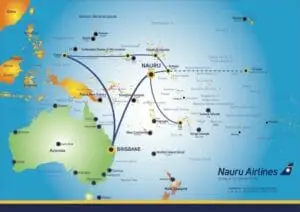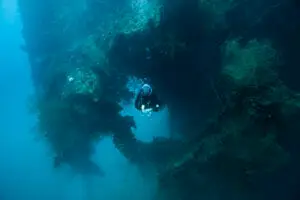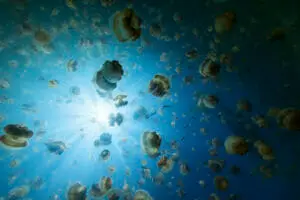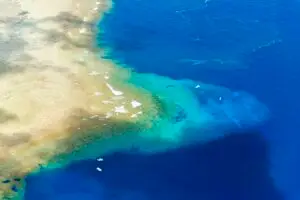🦈 A World First — Palau’s Bold Shark Sanctuary Declaration
In 2009, the Republic of Palau made history by declaring its entire Exclusive Economic Zone (EEZ) — over 600,000 square kilometers of ocean — a shark sanctuary.
It was the first country in the world to do so, instantly elevating Palau from a remote diving paradise to a global leader in marine conservation.
This landmark decision was a direct response to an urgent crisis: the collapse of global shark populations. Over 70 million sharks are being killed each year, primarily for the shark fin trade.
Palau recognized that without intervention, its reefs and its identity as a world-class dive destination were at risk.

Table of Contents
🛑 What the Sanctuary Protects
Palau’s legislation banned all commercial shark fishing, shark finning, and the trade or possession of sharks or their parts. The sanctuary protects both coastal and pelagic species, including:
Grey reef sharks
Whitetip reef sharks
Blacktips
Hammerheads
Tiger sharks
And other migratory species traveling through Palau’s waters
These laws were among the most comprehensive shark protections ever enacted by a sovereign nation at the time.
🌍 A Global Movement Begins
Palau’s sanctuary didn’t just protect local waters; it sparked a worldwide conservation movement. Inspired by Palau, nations like the Maldives, the Bahamas, Honduras, and French Polynesia enacted similar bans, helping build a global network of shark sanctuaries.
Backed by support from NGOs like the Pew Environment Group, Palau’s model showed that even small nations could lead on big environmental issues.
🐟 What It Means for Divers Like You?
Before the sanctuary, shark sightings were frequent, but not guaranteed. Since the ban, shark populations have rebounded dramatically, and dive sites like Blue Corner, Ulong Channel, and Shark City have become famous for high-adrenaline, high-density shark encounters.
Palau is now one of the few places on Earth where sharks are reliably seen on nearly every dive, not because of luck, but because of visionary marine policy.
🧠 Why Sharks Matter: Apex Predators, Reef Guardians
🦈 Sharks Keep Coral Reefs in Balance
Sharks aren’t just dramatic silhouettes gliding through the blue; they are ecological architects. As apex predators, sharks regulate the populations of herbivorous and mid-level fish, ensuring that no one species dominates the reef.
This balance prevents the overgrazing of corals, the collapse of prey species, and the unchecked spread of algae.
Scientific studies, including ones cited in Palau’s marine policy papers, show that reefs with healthy shark populations are more resilient to environmental stressors like warming and bleaching.
In short, sharks keep the reef in check, and the reef keeps the rest of the food web alive.
🪨 What Happens Without Sharks?
If you remove top predators like sharks, the balance of the reef ecosystem breaks down. Smaller predators increase too much, they eat too many plant-eating fish, and that lets algae grow out of control and cover the reef.
The result? Coral decline, biodiversity loss, and fewer fish overall.
Palau’s sanctuary helped prevent this kind of damage by protecting sharks, understanding that a healthy shark population is key to keeping the entire reef ecosystem in balance.
It’s not just a moral choice. It’s functional survival for island communities that depend on healthy reefs for tourism, food, and cultural continuity.
👣 Cultural Respect: Sharks in Palauan Tradition
Long before marine biologists confirmed their ecological value, sharks already held a place of honor in Palauan culture. Certain species were seen as ancestral protectors, their presence a sign of reef vitality and natural harmony.
This deep-rooted respect still influences modern conservation efforts. Traditional leaders and communities supported the sanctuary not just because of science, but because it aligned with chelid — the Palauan ethic of respect for nature, elders, and future generations.
🧭 Conservation with a Compass
Palau’s approach reminds the world that conservation isn’t just about data and enforcement, it’s about values. In combining modern science with traditional wisdom, the Shark Sanctuary embodies a model of cultural-ecological leadership.
It shows that protecting sharks protects everything else, including the livelihoods and identities of the people who live alongside the reef.
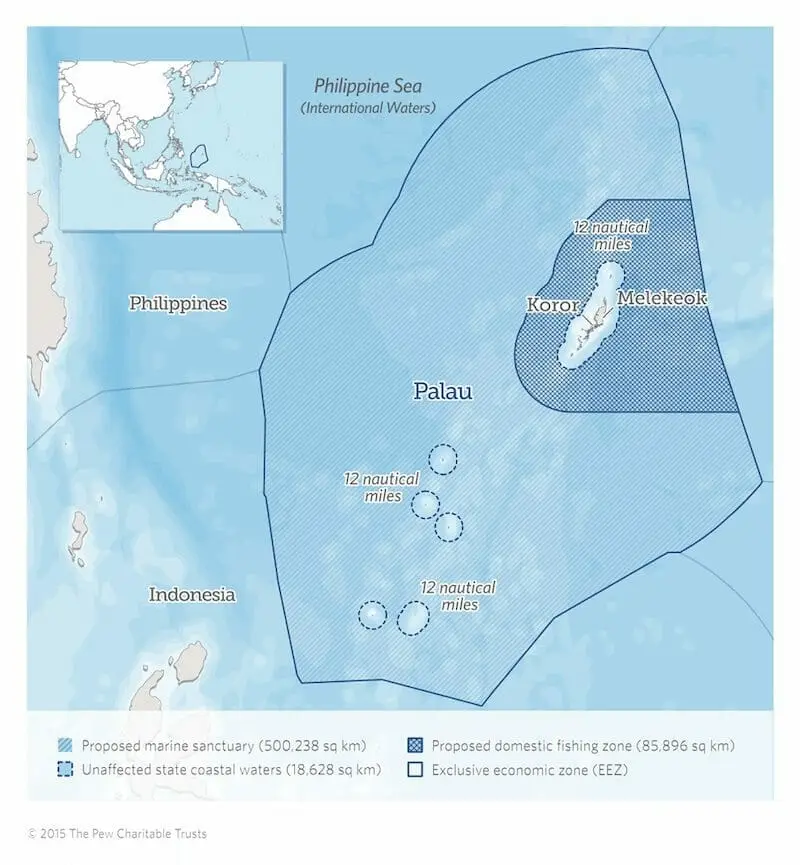
🦈 Shark Species You’ll Likely See in Palau
Palau is one of the few places on Earth where divers can expect to see sharks on nearly every dive.
Thanks to decades of protection under the world’s first national shark sanctuary, reef predators have rebounded in both number and confidence.
Below are the most common shark species you’re likely to encounter when diving in Palau.
Grey Reef Shark
Most iconic. Most visible. Most photographed.
Grey reef sharks are the rock stars of Palau’s dive scene. Known for their confident, schooling behavior and their comfort around divers, they’re especially prevalent at high-current sites like Blue Corner and Ulong Channel.
Size: 1.5–2 meters
Behavior: Often patrol in loose groups, especially during tidal changes
Tip: Watch for their threat display — back arched, pectoral fins down — it’s rare, but unmistakable
These sharks often form the centerpiece of Palau’s “shark show,” appearing in swirling numbers along reef edges and drop-offs.
Whitetip Reef Shark
Quiet. Nocturnal. Cave-loving.
You’ll often find whitetips resting motionless under ledges and inside reef caverns during the day. Unlike most shark species, they can breathe without constant swimming, which makes them relatively easy to photograph in still poses.
Size: 1.5–1.8 meters
Behavior: Hunts at night; rests during the day in groups or solo
Tip: Look under coral shelves or at cleaning stations near Big Drop-Off and Ngemelis Wall
While less showy than their grey cousins, whitetips are a diver’s favorite for their chill presence and photogenic nature.
Blacktip Reef Shark
Shallow, fast, and skittish.
Often seen in lagoons, shallows, and protected reef flats, blacktip reef sharks are sleek, fast, and easy to spot from both boat and snorkel.
Though more common near the surface, they’re occasionally seen darting along deeper reef tops.
Size: 1–1.6 meters
Behavior: Flighty and fast-moving; often seen solo or in small groups
Tip: Best spotted on snorkel tours or shore-access lagoons (especially in calmer weather)
Their distinctive black fin tips and surface-cruising behavior make them easy for new divers to identify.
Rarer Sightings: Whalesharks, Hammerheads, Silvertips & Oceanics
If you’re lucky, deep dives and early mornings may reward you with sightings of:
Scalloped hammerheads — occasionally seen at deeper sites like Peleliu Wall
Silvertip sharks — powerful pelagics spotted in outer reef passes
Oceanic whitetips or tiger sharks — rare, but possible in blue water or night dives
These encounters are less frequent but add a level of awe to diving Palau’s less-visited edges.
🌊 Where to Dive with Sharks in Palau — Top Sites & Seasons
Palau’s shark sanctuary isn’t just a conservation success — it’s a diver’s dream. The sheer number of sharks and their comfort around humans make this one of the best places on Earth for natural, non-baited shark encounters.
But some dive sites in Palau stand out more than others when it comes to frequency, visibility, and shark behavior.
📍 Blue Corner — The Crown Jewel of Shark Diving
Known as one of the best dive sites in the world, Blue Corner delivers the highest concentration of shark sightings in Palau. Divers hook into the plateau a.k.a “The Elbow” and watch the current do the work, bringing in grey reef sharks by the dozen, along with tuna, barracuda, and Napoleon wrasse.
Shark Species: Grey reef, whitetip, occasional blacktip, and silvertip
Conditions: Strong current; best with reef hooks
Pro tip: Time your dive for peak incoming tides for the most shark action
This site has earned a reputation not just for the number of sharks, but for their boldness. The sharks here have grown up in a no-fishing zone and are unbothered by human presence.
📍 Ulong Channel — A Grey Reef Highway
Ulong Channel offers one of Palau’s most exciting drift dives — a sandy-bottomed corridor flanked by coral walls, ending in a spectacular coral garden.
Sharks use this natural channel like a highway, especially during strong tidal flows.
Shark Species: Grey reef, whitetip
Conditions: Moderate to strong current; drift dive
Pro tip: Dive during a strong incoming tide and enter near slack current for maximum sightings
This is one of the best places to see grey reef sharks in formation, gliding effortlessly into the current.
📍 German Channel — Cleaning Stations & Cross-Traffic
While known primarily for manta rays, German Channel is also a solid site for shark encounters, especially at cleaning stations and during spawning cycles.
Shark Species: Grey reef, whitetip, blacktip
Conditions: Variable current, moderate visibility
Pro tip: Watch cleaning stations closely; sharks often cruise through during manta visits
Because it combines two megafauna favorites — sharks and mantas — this site is a must-visit for wide-angle photographers.
📍 Peleliu Wall & the Blue Holes — For the Bold
If you’re an experienced diver seeking something rarer, Peleliu Wall, Blue Holes, and Ngemelis Outer Reef offer deeper sites where hammerheads, silvertips, and even tiger sharks are occasionally seen.
Shark Species: Silvertips, hammerheads, oceanics (rare)
Conditions: Deep water, sometimes extreme current
Pro tip: Best visited with experienced guides during calm surface conditions
These sites are wilder, deeper, and sometimes humbling — they’re not about shark quantity, but shark presence.
📅 Best Time of Year for Shark Diving in Palau
Palau is a year-round dive destination, but certain months deliver better shark visibility and activity:
| Season | Highlights |
|---|---|
| Dec–Apr | Dry season, best visibility, strong currents |
| Mar–May | Peak shark aggregation (spawning in moon cycles) |
| Jul–Sep | Less ideal — rainy season, lower viz |
🛡️ What the Shark Sanctuary Changed — Conservation with Visible Results
🐟 Shark Populations Rebounding
Since the shark sanctuary was established, both scientific studies and diver reports have shown a steady rise in shark numbers and sightings.
Sites like Blue Corner have gone from good to exceptional. Where once you might see a handful of sharks, you now see dozens, sometimes circling above you, cruising the walls, or gliding into cleaning stations.
This recovery isn’t hypothetical. It’s happening in real-time, visible to anyone who dons a mask and dives in.
📈 Eco-Tourism Growth & Local Benefit
The sanctuary hasn’t just benefited sharks — it’s benefited Palauan communities and tourism businesses. By prioritizing conservation, Palau created a rare experience that divers actively seek out.
Shark diving now ranks among the top travel draws to Palau.
Tourists stay longer and spend more on ethical experiences.
Dive operators, guides, and marine rangers have benefited from increased visibility and global press.
And importantly, Palau didn’t lose its fishing culture. By creating a Domestic Fishing Zone alongside the sanctuary, local communities still have access to sustainable food resources while protecting migratory pelagics.
🔁 Global Influence
Palau’s bold move in 2009 helped kickstart a movement. Inspired by the world’s first shark sanctuary, 15+ countries have since followed suit, declaring shark sanctuaries in their EEZs, creating a patchwork of marine protection across the globe.
NGOs like Pew Charitable Trusts and Global Ocean Legacy cite Palau as the proof of concept that shark sanctuaries are politically feasible, economically smart, and ecologically urgent.
🧭 Conservation as Identity
For Palau, the Shark Sanctuary wasn’t just a policy. It was a statement of identity, a continuation of the “bul“, the Palau Pledge, and centuries of reef stewardship.
In protecting sharks, Palau protected its reefs, its economy, its culture, and its standing as a moral leader in ocean conservation.
It remains one of the boldest examples of small-nation leadership with global impact.
🤿 What It Means for Divers — A Rare, Living Legacy
For divers, Palau isn’t just a great destination — it’s a living blueprint of what marine conservation in Palau looks like when a country truly commits.
When you descend into the clear blue of Blue Corner, or drift through Ulong Channel, you’re not just chasing sharks. You’re diving into a national story of leadership, tradition, and ecological resilience.
You’re witnessing what happens when a nation chooses sharks over short-term gain… reefs over revenue… future over fear.
And the results are breathtaking.
You’ll see grey reef sharks curving against the current like arrows. You’ll spot whitetips sleeping in coral caves. You might, if lucky, get a glimpse of a hammerhead at the edge of the blue.
But beyond the animals, you’ll feel something deeper: that this place is protected on purpose, and that your presence here matters.
So when you visit Palau, bring your curiosity, your respect, and your reef hook.
And know this:
You’re not just diving with sharks. You’re diving into a global movement that started right here.
FAQ – Shark Diving in Palau
Yes, Palau established the world’s first national shark sanctuary in 2009, setting a global precedent for marine conservation. The sanctuary covers all of Palau’s exclusive economic zone (EEZ)—over 600,000 square kilometers of ocean—making it illegal to fish, harvest, or harm any species of shark within its waters.
This bold move was driven by declining global shark populations and the country’s deep cultural and ecological connection to its marine environment.
Sharks are critical apex predators that help maintain balance in coral reef ecosystems, and protecting them was seen as essential to long-term reef health and sustainable tourism.
For visitors, this means Palau offers some of the most reliable, ethical shark diving opportunities in the world, with frequent sightings of grey reef sharks, whitetips, blacktips, and even hammerheads in protected areas like Blue Corner, Ulong Channel, and German Channel.
Palau created the shark sanctuary to protect its marine ecosystems, preserve cultural heritage, and lead by example in global ocean conservation.
By the early 2000s, shark populations around the world were plummeting due to commercial overfishing and the shark fin trade. Palau’s government recognized that losing sharks would destabilize reef ecosystems and damage its most valuable natural asset—its ocean.
In 2009, Palau became the first country to declare its entire exclusive economic zone a shark sanctuary, banning all commercial shark fishing and the possession or sale of shark products.
The decision wasn’t just environmental—it was economic and cultural. With over half of Palau’s GDP linked to tourism, healthy shark populations support the thriving dive industry. And culturally, sharks hold significance in Palauan tradition, symbolizing strength and balance.
This visionary policy has since inspired other nations to follow suit, and today, Palau’s reefs are among the most shark-rich and biologically intact in the Pacific.
The Palau Shark Sanctuary encompasses the entire exclusive economic zone (EEZ) of the Republic of Palau—an area covering approximately 600,000 square kilometers of ocean in the western Pacific. That’s nearly the size of France. This vast marine territory includes all of Palau’s open ocean waters, outer reefs, atolls, lagoons, and deepwater drop-offs.
What makes this location extraordinary is its biodiversity and strategic geography. Situated between Indonesia and the Philippines, Palau sits at the heart of the Coral Triangle and serves as a vital corridor for migratory shark species. This includes grey reef sharks, silky sharks, hammerheads, and more.
Popular dive sites such as Blue Corner, Ulong Channel, Siaes Corner, and German Channel all fall within this protected zone—giving divers a front-row seat to one of the largest legally protected shark habitats in the world.
For conservationists and divers alike, the sanctuary’s boundaries aren’t just lines on a map—they represent a bold commitment to protecting apex predators in their natural environment.
Yes — absolutely. Shark diving in Palau is considered very safe.
The sharks most commonly encountered (such as grey reef, whitetip, and blacktip reef sharks) are not aggressive toward humans and are accustomed to divers. Palau’s sanctuary prohibits feeding, which helps maintain natural behaviors. Divers observe sharks in their wild state — curious, alert, and respectful of boundaries.
Most sites are drift dives along reef walls, and experienced dive guides provide clear briefings to ensure safety and comfort, even for first-time shark divers.
The most common species you’ll encounter include:
Grey reef sharks – Social, dominant, and iconic in Palau’s currents
Whitetip reef sharks – Often seen resting during the day
Blacktip reef sharks – Skittish and common in shallower areas
Less frequently, divers may see hammerheads, silvertips, or even tiger sharks in deeper, offshore sites. All of these are protected under the national shark sanctuary.
Whale sharks (Rhincodon typus) are rare visitors to Palau’s waters, but they do occasionally appear—usually as solitary, pelagic passersby. These gentle giants are not resident species, and sightings tend to be unpredictable, often tied to seasonal plankton blooms or oceanic currents that carry food-rich water into the region.
Most encounters happen offshore or in deep blue water, sometimes during liveaboard crossings or in the open ocean beyond the barrier reef. Because they are filter feeders, whale sharks are typically spotted feeding near the surface, making them an unforgettable sight for lucky divers or snorkelers.
While Palau isn’t considered a whale shark “hotspot” like Donsol or Ningaloo, its protected status and nutrient-rich environment mean that when whale sharks do pass through, they do so in safe, undisturbed conditions.
For those hoping to see one, the best approach is to stay alert during blue water dives and ask local dive guides about recent sightings. Though uncommon, it’s not impossible and when it happens, it’s magical.
Bull sharks (Carcharhinus leucas) are extremely rare in Palau. While Palau’s waters support over 130 species of sharks and rays, bull sharks are typically found in more estuarine or brackish environments, such as river mouths and coastal lagoons, habitats that are limited or absent in Palau’s reef-dominated seascape.
Most shark sightings in Palau involve reef-associated species, like grey reef sharks, blacktips, whitetips, and hammerheads.
These species are highly adapted to the outer reef slopes, drop-offs, and strong currents found at sites like Blue Corner, New Drop-Off, and Siaes Corner.
There have been very occasional anecdotal reports of bull sharks seen in deeper, offshore waters, but they are not considered a regular part of Palau’s shark population.
If you’re hoping to see bull sharks specifically, other regions like Fiji or the Bahamas offer more consistent encounters.
That said, Palau’s sanctuary status ensures that whatever species do appear—common or rare—are protected and undisturbed, creating the best possible chance for memorable, ethical shark diving.
Palau offers year-round diving, but shark activity peaks from March to May, especially during spring tides and full moons. These seasonal conditions align with natural spawning and feeding patterns, increasing the chance of schooling behavior and more dynamic encounters.
Yes — Many shark dives are beginner-accessible, especially when accompanied by professional guides. Sites like Blue Corner and Ulong Channel require basic current management skills (using reef hooks), but most certified Open Water divers can participate after a check-out dive.
If you’re unsure, we offer orientation dives and safety briefings to help guests gain confidence before entering more challenging sites.
No. Palau strictly prohibits shark feeding, chumming, or any behavior that alters the natural movement or feeding patterns of marine life. This aligns with the Shark Sanctuary Act and the principles of the Palau Pledge, which all visitors sign upon arrival.
Shark interactions in Palau are 100% natural — no gimmicks, no cages, just pristine conservation-driven diving.
Palau is home to a rich variety of shark species, many of which are regularly encountered by divers thanks to the country’s protected waters.
The most commonly seen sharks include grey reef sharks, whitetip reef sharks, and blacktip reef sharks—all of which thrive in Palau’s strong currents and reef drop-offs.
But Palau’s biodiversity doesn’t stop there.
Divers also have the chance to spot scalloped hammerheads near deep channels, especially during early morning dives at sites like Blue Corner or Peleliu Cut.
Silky sharks and oceanic blacktips may appear in blue water, particularly on liveaboard itineraries. Occasional sightings of tiger sharks and even thresher sharks have also been reported, although they’re far more elusive.
Palau’s position in the Coral Triangle and its ban on shark fishing have turned its waters into a sanctuary not just in name, but in reality, where reef predators can thrive undisturbed.
With healthy populations and consistent sightings, Palau is considered one of the top shark diving destinations in the world.
Yes — shark diving in Palau is very safe, and it’s one of the most rewarding experiences you can have as a diver. Sharks in Palau are accustomed to human presence thanks to decades of responsible, conservation-focused tourism.
These are wild animals, but they are not aggressive toward divers. Most species encountered—such as grey reef sharks, whitetips, and blacktips—are naturally cautious and uninterested in humans.
Dives are conducted by experienced local guides who know how to read conditions, select appropriate sites based on currents and diver experience, and ensure respectful interactions with marine life. Popular shark dives, like those at Blue Corner, Ulong Channel, or German Channel, often involve using a reef hook to stay stable in the current and observe sharks as they cruise past in the blue.
There is no baiting or feeding involved in Palau’s shark diving practices. Instead, you see sharks in their natural behavior and habitat, which makes for both a safer and more ethical experience.
Palau’s commitment to marine conservation, dive safety, and sustainable tourism makes it one of the best and safest places in the world to dive with sharks—whether it’s your first time or your fiftieth.



